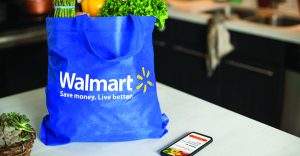The Supply Side: Walmart leads in online grocery with 37% of U.S. market share
by September 4, 2024 1:08 pm 1,438 views

Grocery continues to be the leading online category for Walmart, with the retailer taking share from supermarkets in the second quarter, according to a Brick Meets Click/Mercatus report.
Walmart, excluding Sam’s Club, grew its online grocery market share by 1.5% to 37%, its highest share level to date. Walmart’s second-quarter online grocery sales totaled roughly $8.51 billion, compared to $7.82 billion in the year-ago period.
New online grocery market share analysis shows sales continue to shift away from supermarkets and toward Walmart as households search for more savings, the report notes. Mercatus reports Walmart’s share gain for online grocery is up 7% from two years ago and 9% higher than the mass retailer had in the comparable period of 2021.
“Walmart’s reputation for low prices helped to attract households that wanted both the convenience of shopping online and ways to save money in this market,” said David Bishop, partner at Brick Meets Click. “The execution of its omnichannel strategy, plus the operational efficiencies aided by incredibly high order demand, has enabled Walmart to consistently deliver the type of experiences that customers expect and to lower its cost to serve online orders at the same time.”
Supermarkets ceded 2.5% of their cumulative share in the recent quarter to finish at 27.3%. Since comparable periods in 2021, share loss is 7%, which has been gained by Walmart, Target and other large retailers. Bishop said Walmart began taking some share in early 2022 after the child tax credit ended in 2021 when food and home inflation began outpacing wage growth.
While household debt levels remain manageable, according to the Federal Reserve Bank of New York’s July report, many economists say consumers are more closely watching spending and gravitating toward value.
Mercatus reports Target also took some online grocery share in recent quarters from traditional supermarkets. At the end of June, Target’s share was 7% of the total U.S. online grocery spend. Target’s grocery share was 6.1% in 2022, and 6.5% from the comparable period last year.

Overall, the mass market format captured nearly half of all grocery delivery sales in the second quarter led by nearly an 8% jump in Walmart’s delivery share versus a year ago. Walmart Chief Financial Officer John David Rainey said recently that delivery orders are growing faster than pickup and that’s in part because of the retailer’s expanded express and drone delivery options for its Walmart+ subscribers. He said the profitability of online delivery is also improving as more consumers are willing to pay extra for the express option.
Second-quarter U.S. online grocery sales totaled $23 billion, up 4.46% from the same period last year. Most of the gain came in June. Online grocery spending declined 7% in July to $7.2 billion compared to a year ago, according to a Mercatus report.
Online grocery pickup remains a popular choice, with Walmart claiming 58% of the total share in the second quarter. Pickup sales were down 1% from a year ago in the mass segment. Supermarkets lost 2.1% of their share of online grocery pickup in the second quarter, ending with a share of 28%.
While pickup is losing some share to delivery, Mercatus said store pickup at 45.5% of the total share is still the top method consumers choose. The supermarket segment lags the mass segment with roughly 30% of the share, a gap that narrowed 0.6% from a year ago.
“Regional grocers can safeguard their online business by targeting budget-conscious households with a convenient, seamless and personalized digital experience,” said Mark Fairhurst, Mercatus chief growth officer.
He said competitive pressures on supermarkets don’t appear to be abating as more consumers are buying online from mass retailers. That is true among all income groups.
There are also in-store grocery shopping shifts involving visits and average ticket sales. Despite the growth in online grocery shopping, most food and consumables are still purchased in physical stores.
A report from Placer.ai found consumers are spending less per visit on food as they seek deals. Placer.ai tracked in-store visits over the first half of this year, and while consumers continue to buy some groceries online, they are also out in stores more often. Walmart logged 5% more foot traffic in stores in the first half of this year compared to a year ago. Sam’s Club logged 6% more in-store visits in the year-over-year period. Costco is also a major seller of food, and its in-store traffic was up more than 4.8% in the first half of this year.
R.J. Hottovy, head of analytical research at Placer.ai, said consumers are more value-conscious than they have been in many years.
“Consumers want to spend, but they do not want to spend a lot. They are looking for low prices, unique products and they are shopping at more retailers than ever before, but they are not spending more,” he said.
Placer.ai reports that halfway through 2024, store visits to discount and dollar stores are up 10% over the same period in 2023. As food prices remain elevated, Hottovy said grocery stores have seen 7% more foot traffic year over year. Superstores like mass retailers have seen foot traffic rise about 5.5% year over year. Across all retail, Placer.ai reports store visits are up 5% from the first half of 2023.
Placer.ai reports value grocery store Aldi saw store visits per location increase 12% in the first half of this year from a year ago. Dollar stores also benefited with 9% more visits per location. Warehouse clubs like Sam’s Club and Costco garnered 7% more visits per location this year. Superstores like Walmart saw store visits per location increase by around 4% compared to last year.
He said retailers like Walmart, Costco and Aldi, which have the highest penetration in private brand share, are also winning with consumers on everything from food to health and wellness and that could be online, in-store, or more likely a combination of the two. Hottovy said consumers are agnostic toward shopping modes and seek out retailers that offer them brands they want at the prices they need whether that is online or in-store.
Editor’s note: The Supply Side section of Talk Business & Politics focuses on the companies, organizations, issues and individuals engaged in providing products and services to retailers. The Supply Side is managed by Talk Business & Politics and sponsored by Firebend.
